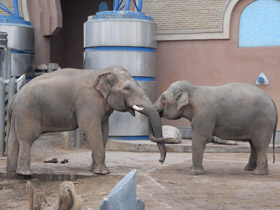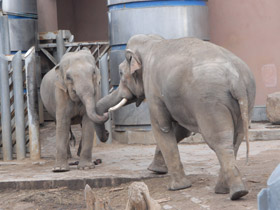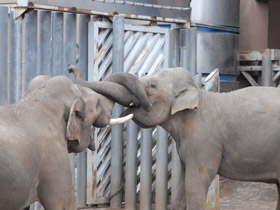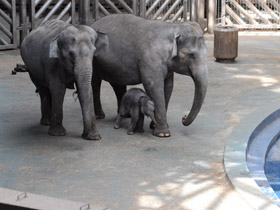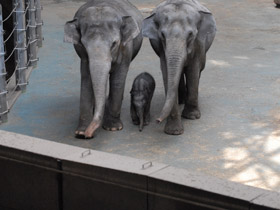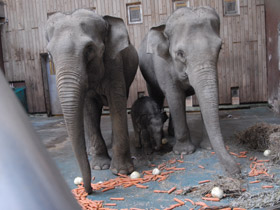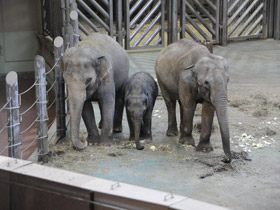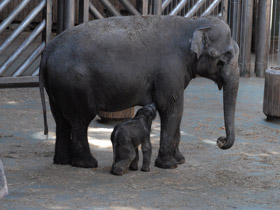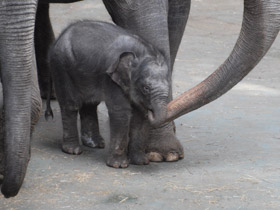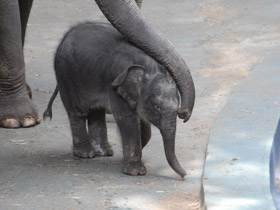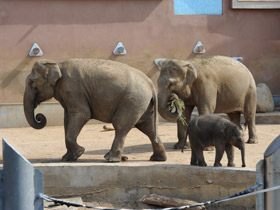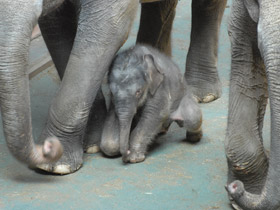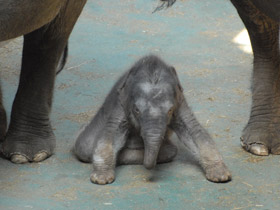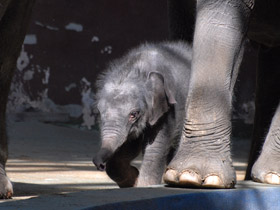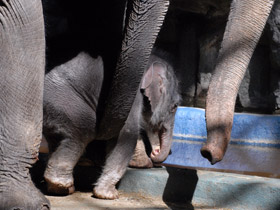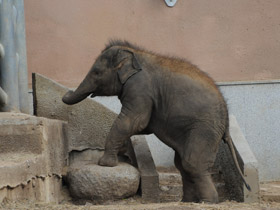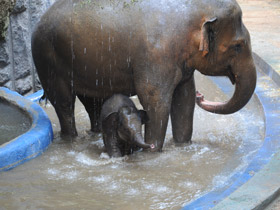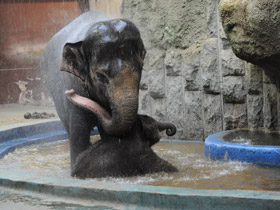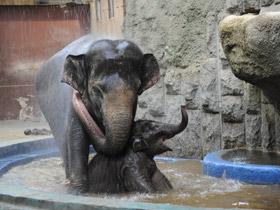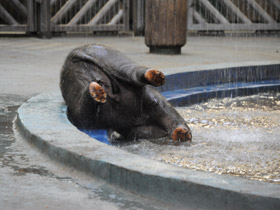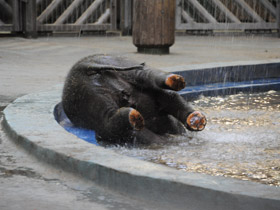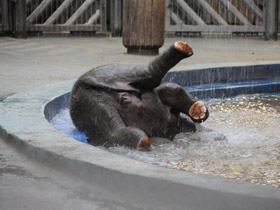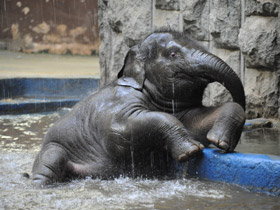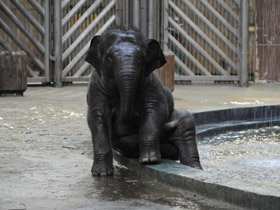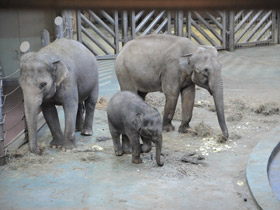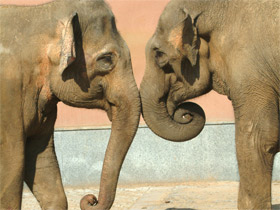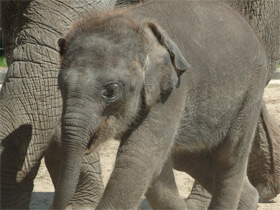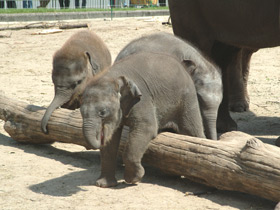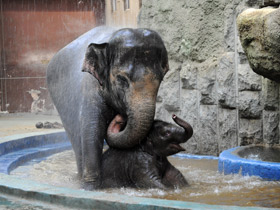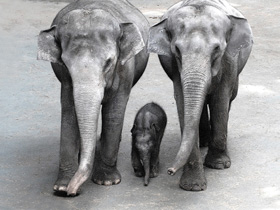The Asian elephant, or Indian elephant Elephas maximus
The Asian (or Indian) elephant is slightly smaller than its African cousin. Asian elephants can be identified by their smaller, rounded ears. Besides, their backs are more convex or level and their trunk has just one “finger”, while African elephants have two. Unlike African elephants, predominantly only male Asian elephants have tusks and even tuskless males are regularly observed.
Asian elephants are extremely sociable animals forming strong family bonds. Life in the family group provides many benefits, including better protection, training of young animals, and easier access to partners for mating. Adult males often live separately, while females stay in family groups. An elephant family consists of one or more usually related adult females and their immature offspring and is headed by leader females called matriarchs. Matriarchs are generally the oldest and largest adult female member of a family. Females continue taking care of their offspring for many years and older daughters look after their younger brothers and sisters. Young females stay in the family group even after they give birth to their own babies, using support of their mothers and submitting their orders. Families of Asian elephants contain from 2 to 7 adult females and their offspring (about 6 or 7 individuals). Field study conducted in Rajaji National Park showed that groups consisting of three or less adult females and their offspring are extremely stable and that the members of such groups spend 90% of their time together. These groups sometimes meet other family groups (probably, related to theirs) but members of the groups do not greet other elephants as excitedly as African elephants do. Above the level of the family unit a second tier of relationships may exist within what is termed a bond group but such groups are formed for short periods.
Like their African cousins, Asian elephants have a well-developed system of communication that makes use of all of their senses – hearing, smell, vision and touch. Apart from acoustic, chemical, and visual communications, elephants use their sense of touch to communicate. Elephants may rub their bodies against one another; they use their ears to rub against another affectionately or in play, or their tails to swat another with force or to gently check for the presence of a calf. An elephant's trunk may be used to reassure or assist a calf, to touch or push another in play, or to caress (Photo 1, 2, and 3).
Elephants love water and can perfectly swim and dive. Baby elephants especially enjoy playing with water (see photos 17 through 24).
Asian elephant males start separating from their family groups at the age of 6 or 7 years. Adult males are usually solitary and join females only when some of them are receptive. When males reach the age of 20 years, they experience periods of must which is periodic state of heightened sexual activity and aggression in adult male elephants. Must is a word of Persian origin and is translated in the languages of Northern India by "condition of poisoning" which precisely describes this specific condition since in the must period a bull produces up to twenty times more of testosterone than in the non-must time. Males in must demonstrate agonistic and aggressive behaviours. In Rajaji National Park the periods of must in largest adult bulls correlate with the time when most of the females are in the oestrous phase. In the male elephants aged over 35 years, must lasts about 60 days and during the whole period of must bulls roam arouns, looking for receptive females.
Extensive studies of elusive forest elephants in the beginning of the 21st century demonstrated that home territories of these animals may be larger than it was thought before and that some elephant groups may live in the areas of 60 sq. km. Radio tracking data suggest that home territories of Asian elephant females reach the sizes of 180-600 sq. km, while male elephants use areas of 160-400 sq. km.
Once-extended range of the Asian elephant has shrunk significantly by our times. This former range covered over 9 million km² but now Asian elephants live in the territory of 500,000 km2. Wild population of the Asian elephant is estimated at 37,000-57,000 individuals and another 15,000 elephants are kept in captivity. In the period of colonization, the British initiated development of new lands in the jungle in India, using tame Indian elephants. Reduction of the wood-processing industry in South and Southeast Asia and Indochina resulted in the decline of captive elephant populations though in some countries, including Myanmar, over 5 thousand elephants are still kept in logging camps.
The main threats to the Asian elephant today are habitat loss, degradation, and fragmentation, which are driven by an expanding human population. Poaching is a major threat to elephants in Asia too. Poachers mainly hunt males for their ivory, which has a significant impact on the long-term breeding results. In Periyar Tiger Reserve in southern India, for example, ivory poaching has dramatically skewed adult sex ratios: over the 20-year period from 1969 to 1989 the adult male:female sex ratio changed from 1:6 to 1:122 and less than one third of all females have offspring aged under 5 years, while in the Rajaji National Park where sex ratio is 1:2, more than 90% of all adult females have offspring. Conflicts between elephants and humans occur in areas, where elephant habitat is close to or adjoining human settlements; every year, up to 300 people and 40-50 elephants are killed during crop raiding in India. Elephant-human conflict poses a grave threat to the continued existence of Asian elephants.
Photo 15: The mother helps little elephant baby walking up stares.
Photo 2: Elephant females keep step with each other.
Photo 6: Females train the baby to select the sweetest carrot.
Photos 7 & 11: The elephant baby has grown up but is still in need of protection of its mother and auntie.

















